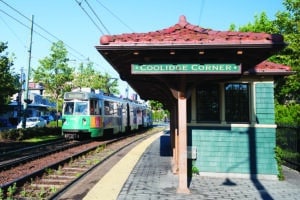
An MBTA Green Line train pulls into Brookline’s Coolidge Corner stop. A closely-watched debate over zoning for more housing in Brookline appears likely to pass, but other communities are raising questions about local officials’ enthusiasm for new development. iStock photo
Gov. Maura Healey laid out one of the most ambitious plans the Bay State has yet seen for tackling the state’s housing crisis last month.
Sky-high home prices and rents are “the biggest challenge facing the people of Massachusetts” Healey noted at the rollout of her multibillion-dollar housing plan, which calls for the development of tens of thousands of new homes, apartments and condos.
Now comes the hard part: Overcoming strong NIMBY sentiment in cities, towns and suburbs across the state so that local officials truly embrace the governor’s call for a dramatic increase in housing production, as opposed to simply paying lip service – or even openly thwarting it.
A case in point is the ongoing debate over the MBTA Communities law, which requires communities across Greater Boston to open the door to as many as 200,000 new housing units near T stations.
Sure, the vast majority of cities and towns have complied with the first stages of the law, which required filing some basic information with state housing officials.
But the real test now looms. A series of deadlines now over the next 15 months will force cities and towns in the MBTA service zone to file actual rezoning documents with the state to open the areas around T stations for housing development.
However, before these rezoning plans can be sent up to Boston, they first have to win a stamp of approval from town meetings and city councils.
And some of the results so far should raise concerns about the willingness on part of some local communities to embrace the governor’s call for action on building new housing.
A Stunning Vote
Candidates from a group called Save Newton’s Villages ousted a slate of veteran members of the Newton City Council who had been strong backers of efforts to pave the way for new housing units near the city’s T stations and its famed 13 “village centers.”
The stunning vote raises questions where this critical initiative may be headed now as Newton faces a Dec. 31 deadline to come into compliance with the MBTA Communities law.
The Newton City Council has been eyeing a rezoning plan that would have gone above and beyond the requirements of the new law. In particular, it would potentially paved the way for more than 10,000 new housing units, including in village centers aren’t on the Green Line or commuter rail.
But the City Council, which is expected to take up the plan this week, will also be confronted with proposals to scale back the rezoning plan down to 8,330 new units – the bare minimum to meet state standards.
Over in Braintree, the outlook is also unsettled when it comes to the town’s efforts to rezone for new housing development around its T station on Ivory Street.
The town council president, who also represents the district in which Braintree’s Red Line station is located, made it clear she sees the requirement to rezone around the station as an opportunity to add housing and boost economic development, with a number of rundown industrial properties nearby.
“It’s a huge opportunity for economic development and economic growth,” Town Councilor Meredith Boericke said, adding the properties near the Braintree T station are “massively undervalued.”

Scott Van Voorhis
Not Just Newton
But the issue of housing development has been a volatile issue in Braintree, with a plan to build a nearly-500-unit apartment complex on mostly-empty parking lots at the South Shore Plaza mall shot down after strong local opposition.
One of the most vocal opponents was outgoing Mayor Charles Kokoros, who was ousted Tuesday by challenger Erin Joyce, the former chair of Braintree’s planning board.
In a puzzling move, Kokoros said he had developed a rezoning plan to comply with the MBTA Communities Act, but declined to release it until after the election.
If nothing else, it’s a sign of how contentious the housing issue has been in the community.
Meanwhile, out on Interstate 495 in Littletown, voters last week shot down the town’s proposed rezoning plan.
All of the above should be a concern to Healey, who has rightly pegged the housing crisis as the biggest challenge facing the state.
Here’s hoping the governor has a plan to deal with this kind of entrenched and stubborn NIMBY opposition.
Otherwise, her multibillion-housing push could wind up on the road to nowhere.
Scott Van Voorhis is Banker & Tradesman’s columnist; opinions expressed are his own. He may be reached at sbvanvoorhis@hotmail.com.




 |
| 
